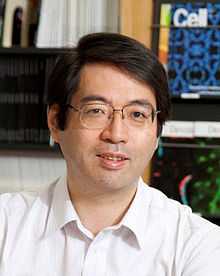Yoshiki Sasai
| Yoshiki Sasai | |
|---|---|
 Yoshiki Sasai, circa 2012 | |
| Born |
5 March 1962 Hyogo, Japan |
| Died |
5 August 2014 (aged 52) Kobe, Hyogo, Japan |
| Nationality | Japanese |
| Fields | Biology |
| Institutions | RIKEN |
| Alma mater | Kyoto University |
|
Website www | |
Yoshiki Sasai (笹井 芳樹 Sasai Yoshiki, 5 March 1962 – 5 August 2014) was a stem cell biologist. He developed methods to guide human embryonic stem cells (hESCs) into forming brain cortex, eyes, and other organs in tissue culture. Yoshiki was one of the founding leaders of the RIKEN Center for Developmental Biology (CDB) in Kobe, a premier research institute for biology in Japan and Director of the Laboratory for Organogenesis and Neurogenesis at the research institute RIKEN.
Sasai was best known for developing new methods to grow stem cells into organ-like structures.[1][2][3][4][5][6][7][8][9]
In 2012, Sasai became the first stem cell researcher to grow an optic cup from human cells.[10]
On August 5, 2014, he was found dead hanging at the RIKEN institute. It is believed that he committed suicide.[11]
Early life and education
Yoshiki Sasai was born in 1962 in Hyogo, Japan. He received his medical degree from Kyoto University's School of Medicine in 1986. He was awarded a PhD from the Kyoto University's School of Medicine in 1993 and recruited to play the sport he loved, American football, for Kyoto University when he studied medicine there. Yoshiki was then a resident at Kobe Municipal General Hospital.
Sasai was married and leaves behind a son and daughter.
Career
Subsequently Sasai worked as a research fellow at Edward M. De Robertis's laboratory at UCLA School of Medicine until 1996.[12] He became an associate professor at Kyoto University in 1996, and a full professor in 1998. In 2003, he moved to the RIKEN Center for Developmental Biology as Director of the organogenesis and neurogenesis group.[13]
STAP controversy
Sasai was a co-author on the paper describing the controversial stimulus-triggered acquisition of pluripotency or "STAP" cells.[14][15] A subsequent investigation cleared him of misconduct but criticized him for inadequate supervision of Haruko Obokata, the lead author of the paper.[16] Some media reports have linked this to his suicide at the RIKEN institute.[17]
Awards and honours
In 2010, Sasai received the Osaka Science Prize for his work on in vitro recapitulation of brain development. He was also the laureate of the 2012 Inoue Prize for Science.[13]
References
- ↑ Cyranoski, D. (2012). "Tissue engineering: The brainmaker". Nature 488 (7412): 444–6. doi:10.1038/488444a. PMID 22914148.
- ↑ Alvarez-Buylla, Arturo (2014). "Yoshiki Sasai (1962–2014) Stem-cell biologist who decoded signals in embryos". Nature 513 (7516): 34. doi:10.1038/513034a.
- ↑ Yoshiki Sasai's publications indexed by the Scopus bibliographic database, a service provided by Elsevier.
- ↑ Kawasaki, H; Mizuseki, K; Nishikawa, S; Kaneko, S; Kuwana, Y; Nakanishi, S; Nishikawa, S. I.; Sasai, Y (2000). "Induction of midbrain dopaminergic neurons from ES cells by stromal cell-derived inducing activity". Neuron 28 (1): 31–40. doi:10.1016/s0896-6273(00)00083-0. PMID 11086981.
- ↑ Piccolo, S; Sasai, Y; Lu, B; De Robertis, E. M. (1996). "Dorsoventral patterning in Xenopus: Inhibition of ventral signals by direct binding of chordin to BMP-4". Cell 86 (4): 589–98. doi:10.1016/s0092-8674(00)80132-4. PMC 3070603. PMID 8752213.
- ↑ Sasai, Y; Lu, B; Steinbeisser, H; Geissert, D; Gont, L. K.; De Robertis, E. M. (1994). "Xenopus chordin: A novel dorsalizing factor activated by organizer-specific homeobox genes". Cell 79 (5): 779–90. doi:10.1016/0092-8674(94)90068-X. PMC 3082463. PMID 8001117.
- ↑ Watanabe, K.; Ueno, M.; Kamiya, D.; Nishiyama, A.; Matsumura, M.; Wataya, T.; Takahashi, J. B.; Nishikawa, S.; Nishikawa, S. I.; Muguruma, K.; Sasai, Y. (2007). "A ROCK inhibitor permits survival of dissociated human embryonic stem cells". Nature Biotechnology 25 (6): 681–686. doi:10.1038/nbt1310. PMID 17529971.
- ↑ Bouwmeester, T; Kim, S; Sasai, Y; Lu, B; De Robertis, E. M. (1996). "Cerberus is a head-inducing secreted factor expressed in the anterior endoderm of Spemann's organizer". Nature 382 (6592): 595–601. doi:10.1038/382595a0. PMID 8757128.
- ↑ Sasai, Y; Kageyama, R; Tagawa, Y; Shigemoto, R; Nakanishi, S (1992). "Two mammalian helix-loop-helix factors structurally related to Drosophila hairy and Enhancer of split". Genes & development 6 (12B): 2620–34. PMID 1340473.
- ↑ Dvorsky, George. "Scientists spark the growth of a human eye with stem cells". io9. Retrieved 6 July 2013.
Moreover, Sasai's breakthrough marks the first time that such a complicated feat was done with human cells.
- ↑ Asahi Shinbun Digital, August 4, 2014
- ↑ "Brief Resume of Dr. Yoshiki Sasai". News & Media. Riken. Retrieved 26 August 2014.
- ↑ 13.0 13.1 "Sayer Vision Research Lecture and Award 2012". National Eye Institute. Retrieved 6 July 2013.
- ↑ Obokata, Haruko; Wakayama, Teruhiko; Sasai, Yoshiki et al. (2014). "Stimulus-triggered fate conversion of somatic cells into pluripotency". Nature 505 (7485): 641–647. doi:10.1038/nature12968. PMID 24476887.
- ↑ Obokata, Haruko (2014). "Retraction: Stimulus-triggered fate conversion of somatic cells into pluripotency". Nature 511 (7507): 112–112. doi:10.1038/nature13598.
- ↑ "Japanese stem cell scientist Yoshiki Sasai found dead in apparent suicide", The Independent, 5 August 2014. Accessed 6 August 2014
- ↑ "Japanese Stem-Cell Scientist Yoshiki Sasai Is Dead". Wall Street Journal. 5 August 2014.
|